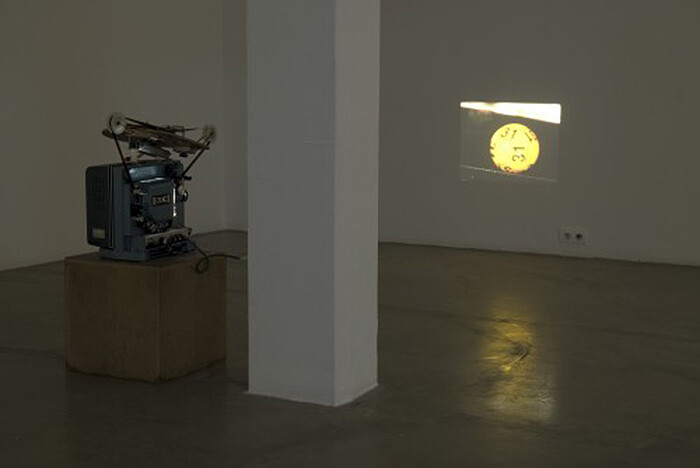November 27, 2010–February 12, 2011
The white box was never so intimate; enclosed in the square-shaped, relatively small room is a man’s seemingly haphazard collection of oddities, triggering a sense of invasiveness upon entering. In “DilSiZ” at Rodeo, Gabriel Lester activates “luck” as a material, thus connecting the dissimilar physical objects in the exhibition.
The experience of the exhibition is marked by the nostalgic hum of the projector, furthering the viewer’s sense of having entered somebody’s personal space. The short 16mm film, Dilsiz (Cleromancy #1) (2010), shows close-ups of a glass lottery ball and a manicured female hand carefully picking the lucky numbers. This action—de-contextualized from the actual process of the lottery with winners, presentation of the numbers and the built-up excitement—is quite futile. The yellow balls are both meaningless and ominous; the video becomes an anchor for the rest of the show, drawing the viewer back with hopes of a conclusion.
Gravity (2010) acts as a foil to the lottery film: every subversive moment of it is one of conclusion and drama. Lester picked out a favorite motif of blockbuster movies, meteorites, or rather some eighty slides of actual meteorite findings, which are looped to give the viewer a strong sense of fulfillment. Lester does not dismiss the meteorite findings; the video is actually quite humble. In the repeated loop of these “finds,” the viewer is invited to discover their own relationship between what is and what could be.
Maybe not surprisingly, the highlight of the show is a small, imaginary souvenir. Fog Ball (2007) is like a snow globe, only, instead of snow, there is fog. The tiny replica of Rome is made invisible by the fog at any moment by merely giving the globe a good shake. It seems only appropriate that this is the earliest work in the show; the rest of the exhibition hinges on the playful, personal yet poetic tone of the fog ball. It is particularly poignant that the Fog Ball is exhibited in a city where millions of lives are often affected by fog every year.
The Fog Ball is formally mirrored by Lady Luck, Glass Bulb (as Part of a Lottery Machine) (2010). This empty glass ball placed on the floor seems like a curious afterthought. Its fragility parallels the self-containment of the very space it occupies. That is, it is within the unlikely space of the gallery that Lester’s eccentric objects become enlivened with a pervasive sense of humanness: a mixture of humility, wonder, incongruity, and, most importantly, curiosity. The name of the exhibition “Dilsiz” (literally, “mute”) takes on an ironic tone, immersed in a humming white box. If anything, Lester has created a welcome space of one too many voices here.




